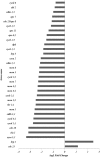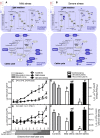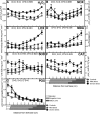Drought Induces Distinct Growth Response, Protection, and Recovery Mechanisms in the Maize Leaf Growth Zone
- PMID: 26297138
- PMCID: PMC4587441
- DOI: 10.1104/pp.15.00276
Drought Induces Distinct Growth Response, Protection, and Recovery Mechanisms in the Maize Leaf Growth Zone
Abstract
Drought is the most important crop yield-limiting factor, and detailed knowledge of its impact on plant growth regulation is crucial. The maize (Zea mays) leaf growth zone offers unique possibilities for studying the spatiotemporal regulation of developmental processes by transcriptional analyses and methods that require more material, such as metabolite and enzyme activity measurements. By means of a kinematic analysis, we show that drought inhibits maize leaf growth by inhibiting cell division in the meristem and cell expansion in the elongation zone. Through a microarray study, we observed the down-regulation of 32 of the 54 cell cycle genes, providing a basis for the inhibited cell division. We also found evidence for an up-regulation of the photosynthetic machinery and the antioxidant and redox systems. This was confirmed by increased chlorophyll content in mature cells and increased activity of antioxidant enzymes and metabolite levels across the growth zone, respectively. We demonstrate the functional significance of the identified transcriptional reprogramming by showing that increasing the antioxidant capacity in the proliferation zone, by overexpression of the Arabidopsis (Arabidopsis thaliana) iron-superoxide dismutase gene, increases leaf growth rate by stimulating cell division. We also show that the increased photosynthetic capacity leads to enhanced photosynthesis upon rewatering, facilitating the often-observed growth compensation.
© 2015 American Society of Plant Biologists. All Rights Reserved.
Figures





References
-
- Aebi H. (1984) Catalase in vitro. Methods Enzymol 105: 121–126 - PubMed
-
- Aparicio OM, Weinstein DM, Bell SP (1997) Components and dynamics of DNA replication complexes in S. cerevisiae: redistribution of MCM proteins and Cdc45p during S phase. Cell 91: 59–69 - PubMed
-
- Ashghizadeh HR, Ehsanzadeh P (2008) Maize (Zea maize L.) performance under drought: decreased photosynthetic area vs. decreased efficiency of PSII. In Allen JF, Gantt E, Golbeck JH, Osmond B, eds, Photosynthesis: Energy from the Sun: 14th International Congress on Photosynthesis. Springer, Dordrecht, The Netherlands, pp 1445–1449
-
- Axelrod B, Cheesbrough TM, Laakso S (1981) Lipoxygenase from soybeans: EC 1.13.11.12 linoleate:oxygen oxidoreductase. Methods Enzymol 71: 441–451
Publication types
MeSH terms
Substances
LinkOut - more resources
Full Text Sources
Other Literature Sources
Molecular Biology Databases

